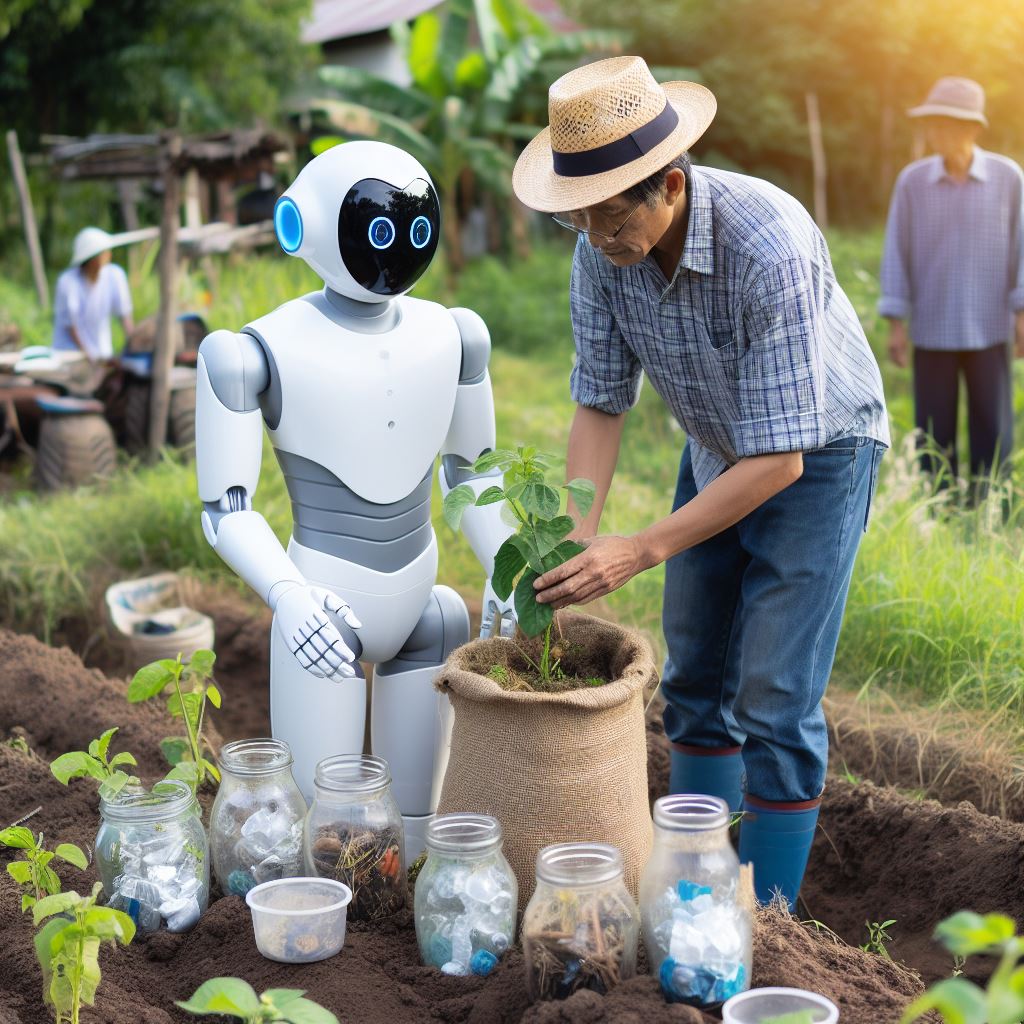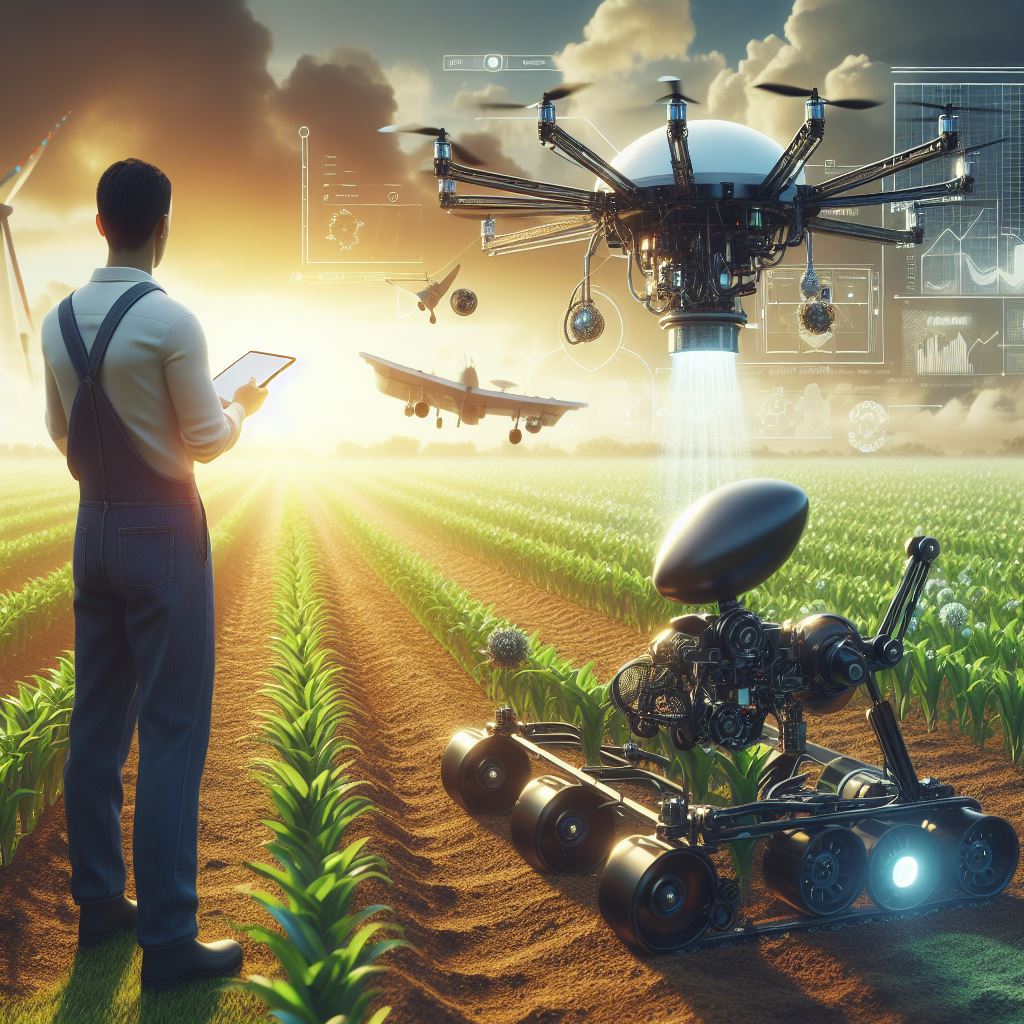Introduction
In the realm of modern agriculture, the integration of Artificial Intelligence (AI) has ushered in a new era of efficiency and precision. Through the amalgamation of data analytics, machine learning, and advanced algorithms, AI has become an invaluable tool for farmers worldwide. Its multifaceted applications span from optimizing crop yields to minimizing waste, revolutionizing traditional farming methods. By seamlessly analyzing vast amounts of data and providing actionable insights, AI Helps Farmers to make informed decisions, adapt swiftly to changing conditions, and ultimately enhance productivity while reducing environmental impact.
The transition from conventional agricultural practices to AI-powered techniques has been marked by a paradigm shift in how farmers approach cultivation and resource management. With AI’s ability to process diverse datasets in real-time, farmers can fine-tune their strategies, precisely monitor crop health, and implement targeted interventions. This transformative technology facilitates a proactive approach, enabling growers to mitigate risks associated with pests, diseases, and unfavorable weather conditions, thereby significantly reducing crop losses and optimizing resource utilization.
The Evolution of Farming Practices
Over time, farming practices have undergone a significant evolution. Initially, agriculture relied heavily on manual labor and traditional knowledge passed down through generations. However, with technological advancements, the landscape began to change. Gradually, innovations like the plow and irrigation systems emerged, revolutionizing cultivation methods. Subsequently, the industrial revolution introduced machinery, enhancing efficiency and scale. As time progressed, the integration of chemical fertilizers and pesticides became commonplace, marking a shift towards modern agricultural practices. Moreover, the advent of genetically modified organisms (GMOs) further transformed farming, promising higher yields and pest resistance. Presently, in this era of rapid technological progress, Artificial Intelligence (AI) has emerged as the latest frontier, reshaping agriculture once again. AI’s ability to process data, analyze trends, and offer predictive insights has ushered in a new phase, promising unparalleled precision and efficiency in farming practices.
Importance of AI in Farming
Artificial Intelligence (AI) holds immense significance in modern farming practices. Firstly, AI technologies enable precise and data-driven decision-making in agriculture. By analyzing extensive datasets gathered from various sources like sensors, drones, and satellite imagery, AI Helps Farmers and provide valuable insights into crop health, soil conditions, and weather patterns. This data-driven approach empowers farmers to make informed decisions, optimizing resource allocation and enhancing crop yields while minimizing waste.
Secondly, AI facilitates the implementation of precision agriculture techniques. Through machine learning algorithms and predictive analytics, farmers can customize their approaches for individual crops and fields. This level of precision allows for targeted interventions such as precise irrigation, targeted pesticide application, and optimal harvesting times. Consequently, it leads to improved efficiency in resource utilization and reduced environmental impact.
Moreover, AI in farming contributes significantly to sustainability efforts. By promoting sustainable practices like minimal chemical usage, optimized resource management, and reduced water consumption, AI aids in creating more environmentally friendly farming systems. These advancements not only benefit the environment but also support the long-term viability of agricultural operations, ensuring food security for growing populations.
Weather Forecasting and Crop Planning
Weather forecasting plays a pivotal role in crop planning, and AI has revolutionized this aspect of agriculture. AI-powered weather forecasting systems leverage historical data, satellite imagery, and real-time weather updates to generate highly accurate predictions. These forecasts go beyond traditional weather models, offering granular insights specific to localized farming areas. Farmers can utilize this information for informed decision-making, adjusting planting schedules, irrigation timings, and crop protection measures based on anticipated weather conditions.
Crop planning, intricately tied to weather forecasts, benefits immensely from AI’s predictive capabilities. By analyzing weather patterns and combining this data with crop-specific information, AI algorithms assist farmers in optimizing their planting strategies. They enable the selection of crops best suited for prevailing climate conditions, minimizing the risk of losses due to adverse weather events. Additionally, AI-driven crop planning allows for diversification and rotation strategies, enhancing resilience against unpredictable weather fluctuations and ensuring a more sustainable agricultural ecosystem.
AI-Driven Resource Optimization
I. Enhanced Water Management with AI
AI revolutionizes water management in farming. Through sophisticated data analysis, AI systems predict water needs based on weather forecasts, soil moisture levels, and crop requirements. Consequently, farmers optimize irrigation schedules, reducing water wastage and ensuring efficient use. Moreover, AI enables the implementation of precision irrigation techniques like drip or smart irrigation, delivering water directly to plant roots, maximizing efficiency, and conserving this precious resource.
II. Smart Nutrient Management Enabled by AI
AI Helps Farmers and plays a crucial role in nutrient management strategies. By analyzing soil composition and plant needs, AI algorithms recommend precise fertilization schedules and types. This tailored approach minimizes overuse of fertilizers, preventing nutrient runoff and environmental pollution. Additionally, AI-driven nutrient management promotes sustainable farming practices, ensuring crops receive the necessary nutrients while safeguarding soil health for long-term productivity.
III. AI-Optimized Pesticide Usage for Sustainable Agriculture
In pesticide management, AI Helps Farmers and offers significant advancements. AI-powered systems analyze pest behavior, crop health data, and environmental factors to predict pest outbreaks accurately. This enables farmers to apply pesticides only when and where needed, reducing overall usage and minimizing ecological impact. Consequently, AI-driven pesticide optimization fosters environmentally friendly farming practices while maintaining effective pest control measures, ensuring healthier crops and ecosystems.
Robotics and Automation in Farming
Robotics and automation have revolutionized traditional farming practices. Initially, manual labor was the backbone of agricultural activities. However, with technological advancements, robotics entered the scene. First, basic machines simplified tasks like planting and harvesting. As technology evolved, sophisticated robots emerged, equipped with AI-driven capabilities. These robots can autonomously perform intricate tasks, from precision planting to selective harvesting, ensuring efficiency and accuracy.
Furthermore, automation in farming streamlines operations. Robots equipped with sensors navigate fields, detecting weeds or monitoring crop health. This real-time data aids in making swift decisions, such as targeted spraying or precise interventions. Consequently, it reduces labor demands and optimizes resource utilization.
In this era of rapid technological progress, robotics and automation represent the future of farming, promising increased productivity and sustainable agricultural practices.
AI Solutions for Waste Reduction
- Data-Driven Decision Making: AI utilizes vast datasets to predict potential areas of waste. By analyzing historical information and current trends, AI identifies inefficiencies in farming practices, allowing farmers to adjust strategies accordingly.
- Precision Application of Resources: AI Helps Farmers and enables precise application of water, fertilizers, and pesticides. By assessing crop needs and environmental conditions, AI algorithms optimize resource usage, minimizing excess and reducing waste.
- Predictive Maintenance: AI-powered sensors monitor equipment health and performance. Predictive maintenance algorithms detect issues before they escalate, ensuring machinery operates optimally, reducing downtime, and preventing unnecessary resource wastage.
- Post-Harvest Management: AI helps in managing post-harvest processes. By analyzing storage conditions and shelf-life data, it minimizes spoilage, ensuring better quality and reduced waste of harvested crops.
- Optimizing Supply Chain Efficiency: AI streamlines logistics and distribution. Through predictive analytics, it optimizes transportation routes and storage, minimizing delays and ensuring timely delivery, thereby reducing overall wastage in the supply chain.
Ensuring Responsible AI Use in Farming Practices
- Ethical Data Handling: Ensure ethical collection, storage, and usage of agricultural data, respecting privacy rights and confidentiality agreements with farmers.
- Transparent Algorithms: Implement AI systems with transparent algorithms, enabling farmers to understand how AI-driven decisions are made regarding their crops and operations.
- Accountability in Decision-Making: Establish clear accountability for AI-generated recommendations or actions, allowing farmers to question and understand the reasoning behind AI-driven suggestions.
- Continuous Monitoring and Validation: Regularly monitor and validate AI systems to ensure their accuracy, reliability, and relevance in diverse agricultural settings.
- Human Oversight and Intervention: Maintain human oversight in AI-driven processes, enabling farmers to intervene or override AI recommendations based on their expertise and on-the-ground knowledge.
- Bias Mitigation: Mitigate biases in AI algorithms by ensuring diverse and representative datasets to prevent discriminatory or inaccurate outcomes in decision-making.
- Regulatory Compliance: Ensure compliance with agricultural regulations and standards, aligning AI use with legal frameworks and ethical guidelines established by governing bodies.
- Education and Training: Provide comprehensive education and training to farmers and agricultural stakeholders on AI use, its benefits, limitations, and ethical considerations.
- Sustainability Integration: Integrate AI practices that promote sustainable farming, minimizing environmental impact, and prioritizing long-term ecological balance.
- Community Engagement and Feedback: Encourage farmer participation and feedback loops in the development and improvement of AI systems, fostering a collaborative approach towards responsible AI integration in agriculture.

AI Collaboration among Farmers and Research Institutions
I. Fostering Collaborative Networks
Collaboration among farmers and research institutions forms the cornerstone of AI integration in agriculture. By fostering networks, information sharing becomes seamless. Through forums, workshops, and digital platforms, stakeholders collaborate, exchanging insights and experiences, fostering a culture of mutual learning and innovation.
II. Sharing Data for Collective Insights
Data sharing plays a pivotal role in AI-driven agriculture. Farmers and research institutions contribute diverse datasets, encompassing crop information, soil health, and weather patterns. These collective datasets, when integrated, form a robust foundation for AI models, allowing for more accurate predictions and comprehensive insights into agricultural practices.
III. Co-Creation of AI Solutions
Collaboration enables the co-creation of AI solutions tailored to agricultural needs. Farmers contribute practical insights gained from field experience, while research institutions provide technical expertise. Together, they co-develop AI tools that address specific challenges faced on the ground, ensuring practical applicability and efficacy.
IV. Testing and Validation in Real-world Settings
Collaborative efforts involve testing AI applications in real-world farming settings. Research institutions work closely with farmers to deploy and validate AI models. This collaboration allows for fine-tuning algorithms, ensuring they align with diverse farming practices and are adaptable to various environmental conditions.
V. Scaling Up Adoption and Impact
Through collaboration, the aim is to scale up the adoption of AI in agriculture. Successful models and practices developed through joint efforts are disseminated widely. This wider adoption leads to a broader impact, benefiting more farmers and contributing to the advancement of sustainable and efficient farming practices.
Conclusion
The integration of Artificial Intelligence (AI) has emerged as a transformative force, revolutionizing traditional farming practices. AI’s applications, ranging from precision agriculture techniques to data-driven decision-making, have significantly bolstered crop yields while concurrently minimizing waste. By harnessing the power of AI-driven analytics, farmers can now make informed decisions, optimizing resource allocation, and enhancing crop health. This technological evolution has not only streamlined processes but has also enabled sustainable farming practices, aligning with environmental conservation goals.
Furthermore, AI’s role in waste reduction within the agricultural sector cannot be overstated. Through predictive analytics, precise resource management, and targeted interventions, AI Helps Farmers and minimizes post-harvest losses and optimizes resource utilization. This not only ensures food security but also promotes economic sustainability for farming communities.
As AI continues to advance, its collaboration among farmers, research institutions, and technology developers is pivotal. This collaborative synergy fosters innovation, ensuring that AI solutions are tailored to meet the diverse and evolving needs of the agricultural landscape. Ultimately, the widespread adoption of AI in farming holds the promise of a more efficient, sustainable, and resilient agricultural future.

